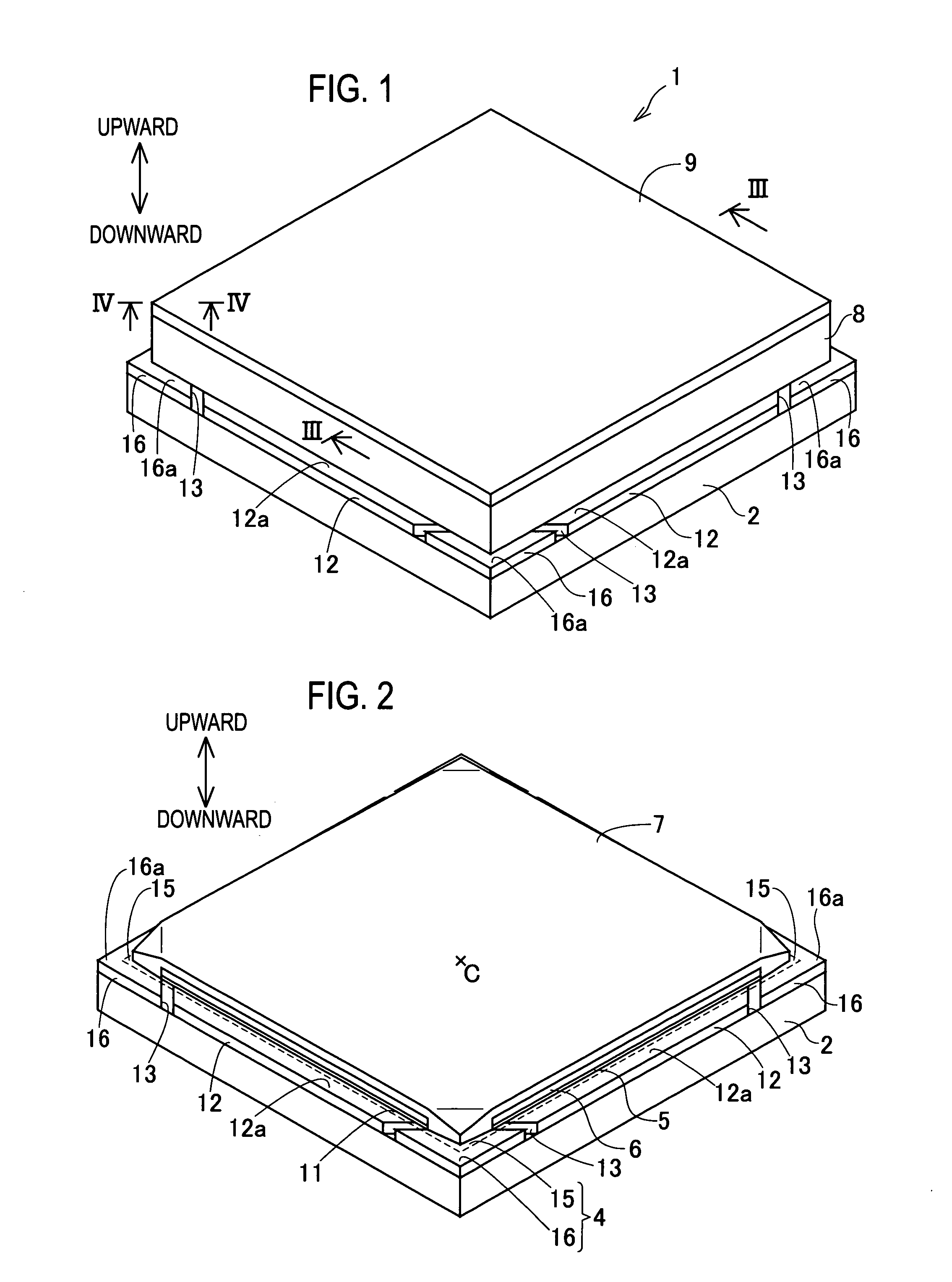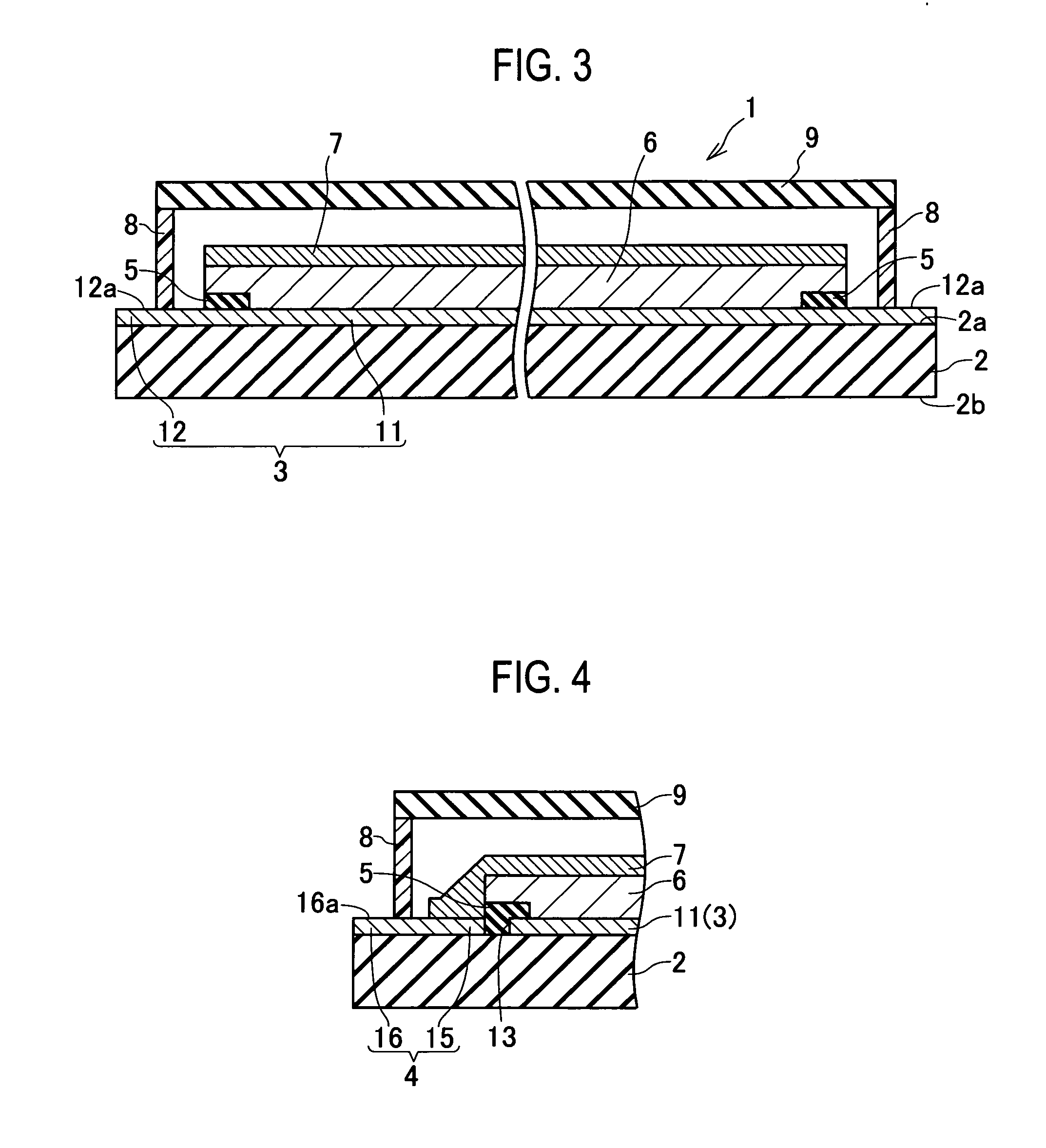Organic el device
- Summary
- Abstract
- Description
- Claims
- Application Information
AI Technical Summary
Benefits of technology
Problems solved by technology
Method used
Image
Examples
first embodiment
[0063]Hereinafter, a first embodiment that applied the present invention to a bottom emission type organic EL device will be described, with reference to drawings. FIG. 1 is a whole perspective diagram showing an organic EL device according to the first embodiment. FIG. 2 is a whole inside perspective diagram showing the organic EL device which removed a sealing plate. FIG. 3 is a cross-sectional diagram taken in line of FIG. 1. FIG. 4 is a cross-sectional diagram taken in line IV-IV of FIG. 1. FIG. 5 is a top view showing a first transmissible electrode and a second transmissible electrode. In the following explanation, upward and downward shown by an arrow of FIG. 1 is applied to an up-and-down direction.
[0064]As shown in FIG. 1 to FIG. 5, the organic EL device 1 according to the first embodiment includes: a substrate 2; a first transmissible electrode 3; a second four transmissible electrodes 4; an insulating layer 5; an organic light emitting layer 6; a cathode (second electrode...
second embodiment
[0097]Next, an organic EL device according to a second embodiment that modified a part of the first embodiment mentioned above will be explained, with reference to drawings. FIG. 16 is a whole perspective diagram showing the organic EL device accroding to the second embodiment. FIG. 17 is a top view showing a transmissible electrode. In FIG. 16, dashed lines show a sealing material 8 and a sealing plate 9 for convenience. Also, in FIG. 17, dashed lines show the periphery of the sealing material 8. The same configuration as the first embodiment attaches the same reference numeral, and therefore omits the explanation.
[0098]As shown in FIG. 16 and FIG. 17, in the organic EL device 1A according to the second embodiment, the shape of the first transmissible electrode 3A and the second transmissible electrode formed on the substrate 24A is different from that of the first embodiment.
[0099]The first transmissible electrode 3A is formed in the cross shape in regions except near the vertex o...
third embodiment
[0102]Next, an organic EL device according to a third embodiment that modified a part of the first embodiment mentioned above will be explained, with reference to drawings. FIG. 18 is a top view of a transmissible electrode according to the third embodiment. In FIG. 18, dashed lines show the periphery of the sealing material 8. In addition, the same configuration as the embodiment mentioned above attaches the same reference numeral, and therefore omits the explanation.
[0103]As shown in FIG. 18, in the organic EL device according to the third embodiment, the shapes of the first transmissible electrode 3B formed on the growth principal surface 2a of the substrate 2 (refer to FIG. 3) and the second transmissible electrodes 4B are different from the first embodiment.
[0104]The first transmissible electrode 3B is formed in the approximately whole surface of the growth principal surface 2a except that the central part of each side of the growth principal surface 2a of the substrate 2 is re...
PUM
 Login to View More
Login to View More Abstract
Description
Claims
Application Information
 Login to View More
Login to View More - R&D
- Intellectual Property
- Life Sciences
- Materials
- Tech Scout
- Unparalleled Data Quality
- Higher Quality Content
- 60% Fewer Hallucinations
Browse by: Latest US Patents, China's latest patents, Technical Efficacy Thesaurus, Application Domain, Technology Topic, Popular Technical Reports.
© 2025 PatSnap. All rights reserved.Legal|Privacy policy|Modern Slavery Act Transparency Statement|Sitemap|About US| Contact US: help@patsnap.com



